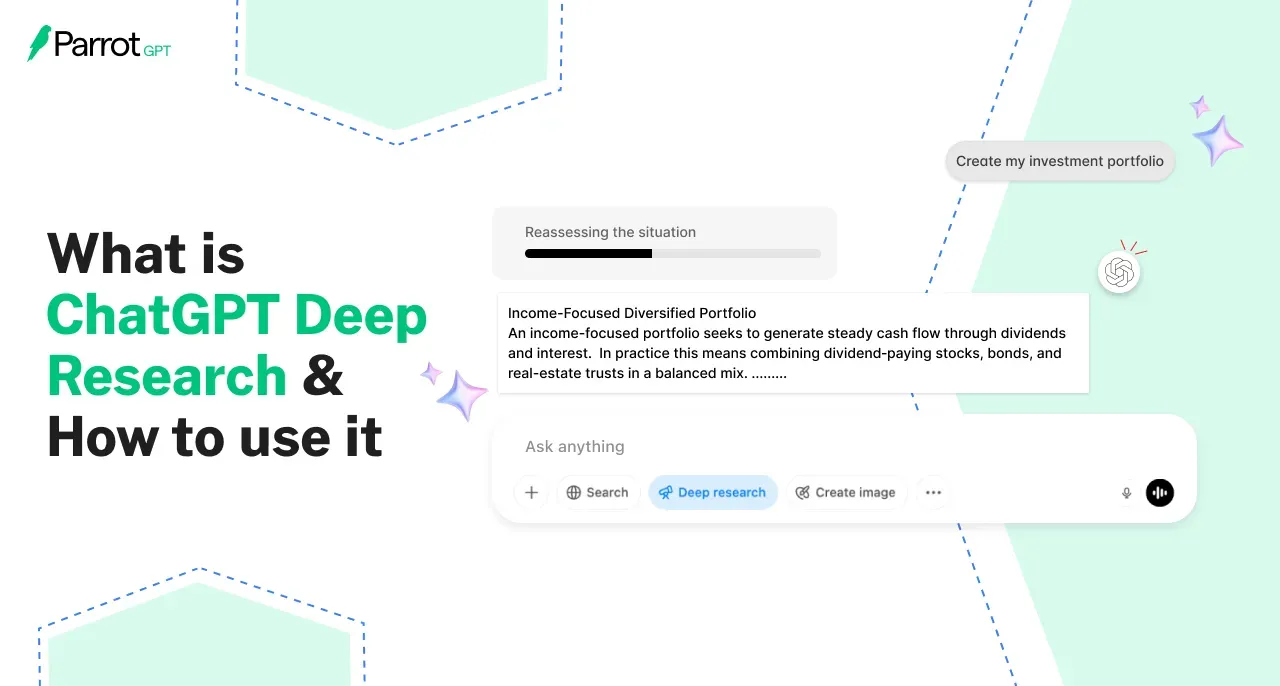Introduction
Have you ever wished research could be faster, more reliable, and less overwhelming?
ChatGPT just made that possible.
With its new Deep Research mode, you can dive into complex topics without spending hours flipping through unreliable sources. Unlike traditional searches or basic AI summaries, Deep Research goes beyond the basics.
It’s like having a research assistant that’s always ready to help—except this assistant is powered by AI.
Curious to see how it works and how it can transform your research process?
Keep reading to uncover how ChatGPT Deep Research is revolutionizing the way we dig into topics, streamline findings, and make better-informed decisions. But first…
What is ChatGPT Deep Research?
It is a feature within ChatGPT, designed for in-depth research tasks.
Unlike standard responses, it goes beyond simple summaries. Deep Research ChatGPT digs into credible sources, applies reasoning, and presents structured results with inline citations..
Using a specialized version of OpenAI’s o3 model, this mode performs comprehensive searches and multi-step analysis.
The process usually takes 5 to 30 minutes, during which the AI evaluates data, summarizes key points, and ensures each claim is backed by verifiable references.
This feature is perfect for users needing thorough, precise information, offering clear answers supported by real sources—no guesswork
As you can see in the image above, ChatGPT Deep Research can be accessed directly under the message box as a quick-select button.
In some cases, it also appears at the top, alongside modes like Default and Browse.
If you don't see it immediately, click the mode selector near the chat title or open the Explore GPTs section to find and activate it.
Placement may vary slightly depending on updates or settings.
Now, let’s break down how it works—and what makes it different from a regular ChatGPT response.
Inside Deep Research Mode
ChatGPT Deep Research works like a focused research assistant.
But smarter—and faster.
When this mode is turned on, it goes beyond ChatGPT’s training data.
It actively browses the web, filters noise, and pulls in high-quality information.
You won’t get summaries from outdated sources. You’ll get well-structured responses with real citations.
Links to actual articles. Academic papers. Official reports. No vague claims. No made-up facts.
This is research you can trace—and trust.
How It’s Different from Regular ChatGPT
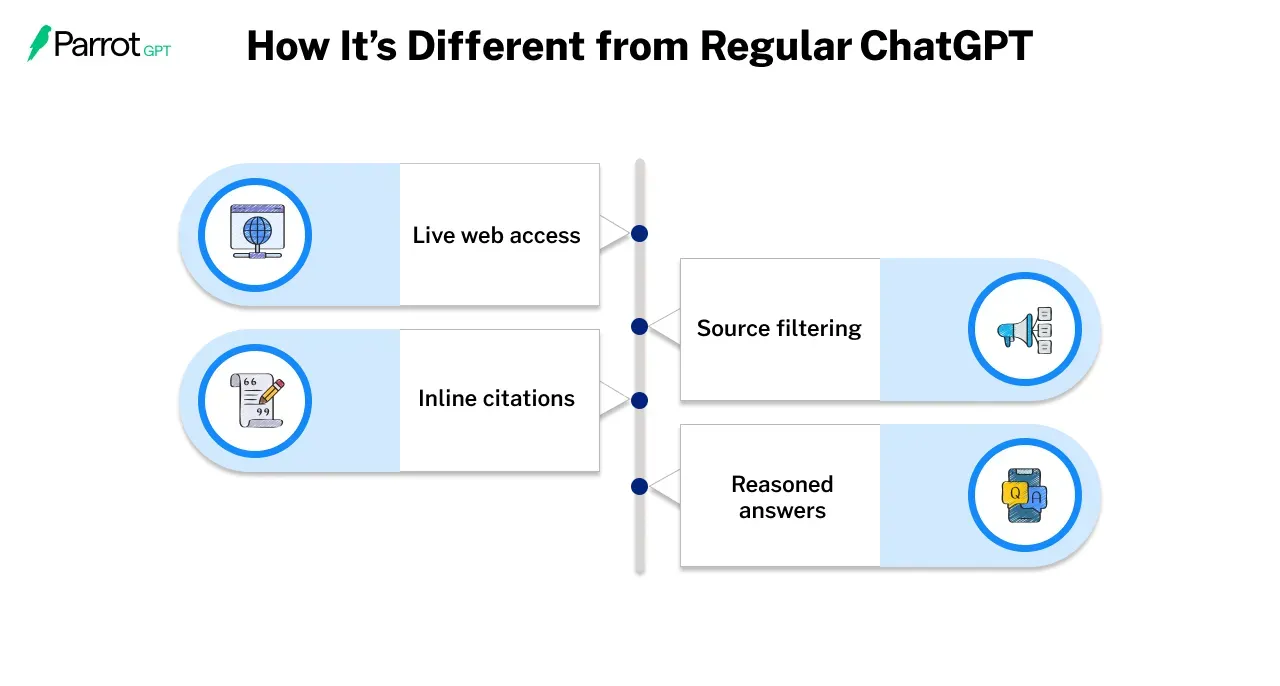
Normal ChatGPT responses rely on old data. They’re quick, but not always reliable for high-stakes work.
Deep Research ChatGPT Plus mode upgrades that.
It includes:
- Live web access
- Source filtering to prioritize authority
- Inline citations for transparency
- Reasoned answers, not just pattern-based guesses
This isn’t about writing faster—it’s about thinking better. Perfect for when the stakes are high and accuracy matters.
Strengths That Stand Out
Once you start using ChatGPT Deep Research, the difference isn’t just in how it works, but in what you get out of it.
You don’t just get information. You get answers you can trust.
Instead of digging through articles or checking citations yourself, you get research-ready insights—formatted, sourced, and ready to use. It’s built for fast-paced, high-stakes work where the details matter.
Whether you’re drafting a report, prepping for a client call, or comparing data for a strategic decision, this mode helps you skip the noise and focus on what’s useful.
No vague summaries. No guessing games. Just structured responses with logic and links to back it up.
That’s what sets it apart—not just smarter responses, but more usable ones.
How Does ChatGPT Deep Research Work?
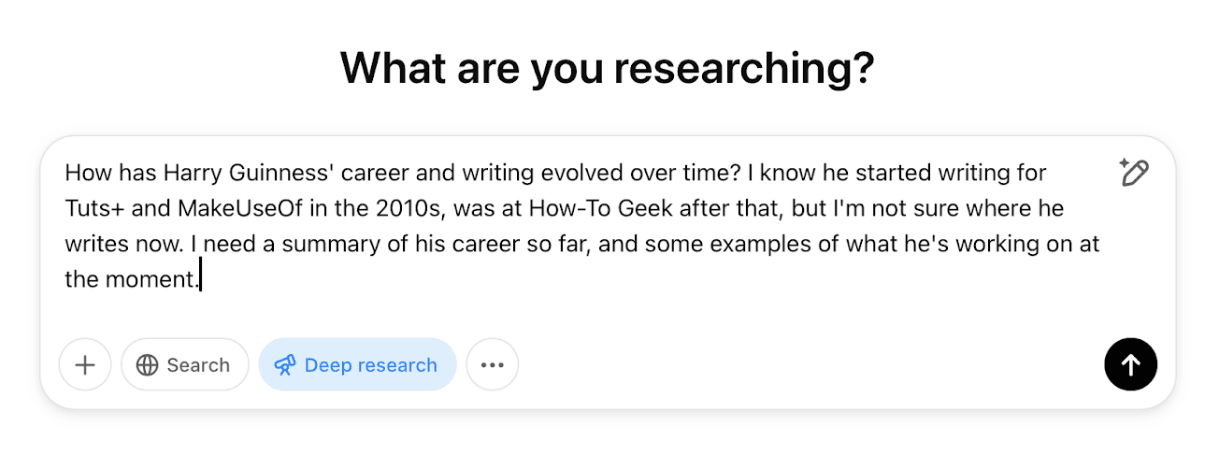
By now, you understand what ChatGPT Deep Research is—and why it matters.
But what’s actually going on behind the scenes?
This section breaks it down.
Because when you’re using a tool for critical research, you should know how it pulls data, why it shows certain answers, and what makes it more trustworthy than a quick Google search or a generic chatbot.
Let’s take a closer look at how this mode turns noisy online information into clear, structured insights you can rely on.
It Starts With Real-Time Web Access
When you activate Deep Research ChatGPT, you’re not just asking ChatGPT to pull from its training data.
It goes live.
This mode opens a real-time browsing process. The AI actively scans the internet, not to flood you with results, but to collect up-to-date, high-quality information.
It pulls content from reputable sites, academic sources, government databases, and trusted publications.
No Reddit threads. No Quora opinions. No fluff.
The system is trained to know the difference.
Source Filtering: Cutting the Noise
One of the major upgrades in Deep Research ChatGPT Plus is how it filters sources.
It doesn’t just bring back everything it finds. Instead, it prioritizes credibility over volume.
Here’s how:
- It cross-checks claims from multiple sources
- It scores pages based on author authority, domain reliability, and content quality
- It automatically avoids clickbait, low-domain-rank sites, or outdated pages
So when you get a summary, it’s already passed through multiple layers of quality control.
You’re not just getting fast info—you’re getting curated knowledge.
Synthesis: Making Sense of Complex Info
Once sources are selected, ChatGPT Deep Research doesn’t just copy-paste what it finds.
It synthesizes.
This means:
- It compares what different sources are saying
- It pulls out the consistent facts
- It builds a coherent response from them
- It leaves out the fluff, contradictions, or edge cases (unless you ask for them)
This ability to digest and rewrite is what sets it apart from simple search tools.
And it's especially helpful when dealing with research-heavy questions that would otherwise take hours to dig through.
Suggested Reading:
Optimize User Experience with ChatGPT Plugins
Structured Output: Easy to Read, Easy to Trust
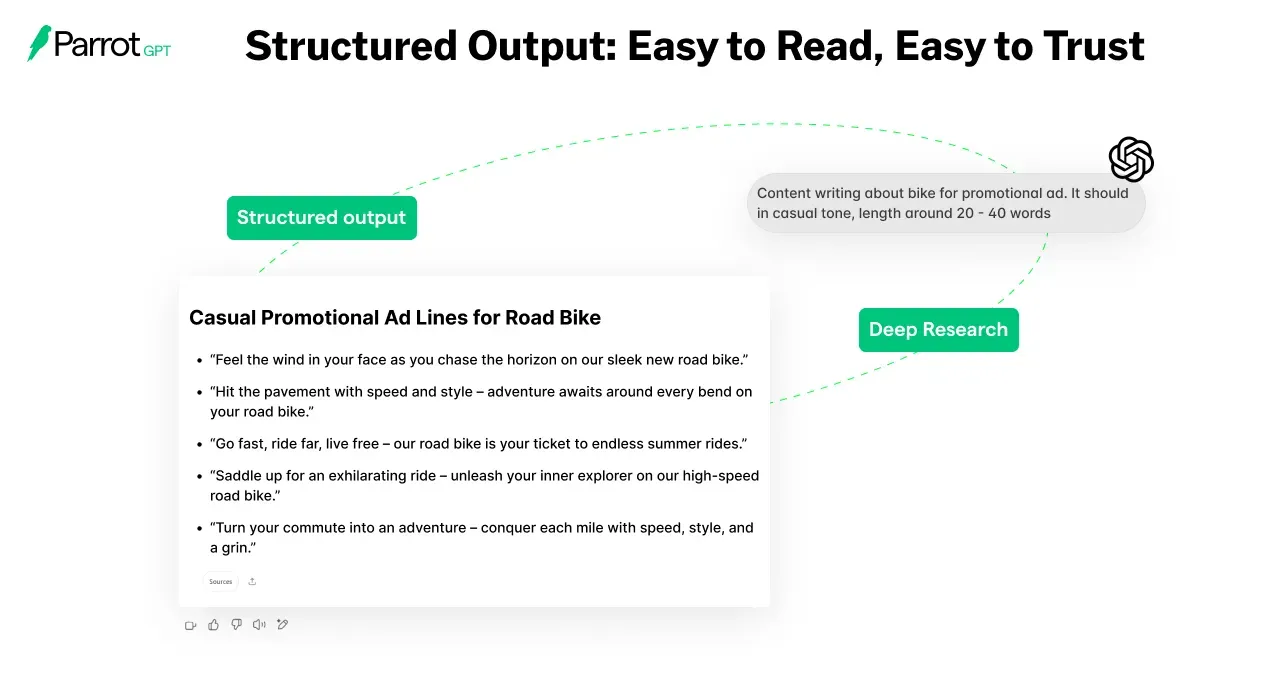
Every response is designed for fast understanding.
Instead of dumping a wall of text, it gives you:
- Clear headings
- Bulleted lists
- Step-by-step explanations
- Highlighted points
- Inline citations with links you can click
This makes it perfect for quick scanning on mobile or building into documents and briefs.
So, if you’re wondering how to use ChatGPT Deep Research for reporting or analysis, this structure is the key.
It saves you from having to clean up or reformat AI output later.
Quality Over Quantity—Always
Some tools brag about speed. This one focuses on accuracy.
ChatGPT Deep Research isn’t trying to give you the fastest answer. It’s built to give you the best one.
This shows up in:
- Fewer, but more reliable citations
- Slower responses (because it’s thinking through the synthesis)
- Better alignment with your intent, not just keywords
In short: It’s designed to help you work smart, not just fast.
Who Should Use ChatGPT Deep Research?
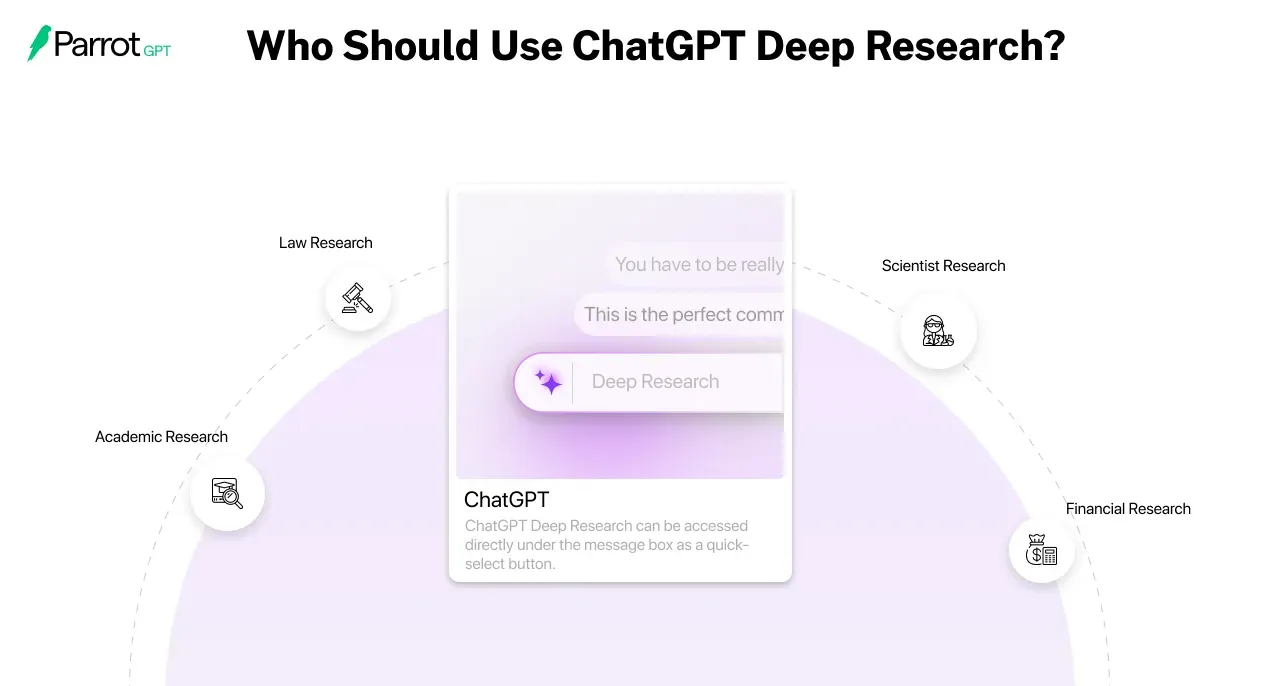
Some jobs rely on speed, others on accuracy—but if you need both, Deep Research ChatGPT is built with you in mind.
This mode is especially helpful for:
- Legal professionals verifying citations, interpreting laws, and cross-checking regulations
- Finance teams conducting market analysis, sourcing economic data, or preparing investor reports
- Academic researchers summarizeing papers, identifying credible sources, and building literature reviews
- Scientists and analysts comparing studies, evaluating claims, and filtering bias from results
- Informed consumers and advanced users who value citations and structured reasoning over guesswork
So, when does it make sense to use this over traditional browsing or even standard ChatGPT?
Use ChatGPT Plus Deep Research when:
- You’re writing a report or whitepaper
- You’re evaluating multiple expert opinions
- You’re drafting a proposal or investor memo that requires verifiable support
- You’re fact-checking fast-moving topics—like emerging tech, policy shifts, or market trends
- You want to save time without cutting corners
It’s not for casual queries like “what’s for dinner” or “movie trivia.” It’s for people who need reliable answers when decisions (or reputations) are on the line.
Where to Find It?
Deep Research is currently available only to ChatGPT Pro subscribers, so you won't see the option if you’re on the free plan.
Here’s how to locate and activate it:
- Log in to ChatGPT with your Pro account
- Open a new chat window
- Click the dropdown at the top that lets you choose between models
- Under GPT4, select “Deep Research”
- You’ll know it’s active when you see a system message confirming real-time browsing and citation capabilities
It’s that simple—no plugins or browser extensions required.
While the feature works on both desktop and mobile, it’s best used on desktop. Longer outputs are easier to scan, citations are more readable, and layout formatting is cleaner.
That said, it’s fully mobile-compatible—just expect a bit more scrolling when reading structured answers or comparing sources.
How to Use ChatGPT Deep Research Effectively
Now that you know what ChatGPT Deep Research is, who it’s for, and how to access it, the next step is using it well.
This isn’t your typical AI experience—you’ll get the best results when your approach is intentional.
Unlike standard search tools or everyday ChatGPT prompts, this mode thrives on clarity and follow-through.
It’s designed for those who need substance over summaries—people who ask precise questions, build context through follow-ups, and care about citing sources.
Let’s break down how to make the most of it in real research workflows.
Ask Specific, Structured Questions
To get real value from ChatGPT Deep Research, avoid vague or open-ended questions.
For example, asking, “Tell me about inflation” gives you a high-level overview.
But asking: “What are the primary drivers of U.S. inflation in 2024, with citations from financial institutions or economists?” invites a sharper, better-sourced response.
This isn’t guesswork—it’s powered by live research and source validation.
The tool knows how to sift through the noise, but it needs a clear prompt to work with.
Effective prompt styles include:
- “List the top findings from 2024 studies on renewable energy in the EU.”
- “Compare expert analysis on hybrid work culture productivity across different countries.”
- “Summarize legal commentary on the impact of the EU AI Act.”
When you give enough detail, Deep Research ChatGPT adapts, providing organized, credible insights ready for professional use.
Suggested Reading:
Enhance Customer Interactions with ChatGPT Conversational AI
Use Follow-Up Prompts to Refine Results
The initial answer is just the start. What makes this tool powerful is how well it supports follow-up prompts.
Say you asked for a breakdown of proposed tax reforms in Canada. Your next step could be:
“Which groups are expected to be most affected by these reforms, and why?” or “Can you summarize economic opinions on the long-term effects of these changes?”
Each follow-up builds depth, and the research assistant responds accordingly.
You can use follow-ups to:
- Drill into comparisons (e.g., “How do these reforms contrast with U.S. policy?”)
- Ask for synthesis (e.g., “Combine insights from all sources into key takeaways.”)
- Revisit a specific citation (e.g., “What else does the 2023 OECD report say on this topic?”)
Whether you're working in policy, finance, or science, this layered approach turns ChatGPT Plus Deep Research into a reliable assistant, not just a one-off tool.
Cross-check with Provided Sources
One of the most important habits to build: validate what you’re reading.
With this tool, every major claim includes a clickable citation—whether it’s a news article, official report, or academic paper. This transparency is a major upgrade over regular ChatGPT.
Especially in regulated industries like law, healthcare, and finance, double-checking the source is essential.
Don't just take AI at face value—read the context around the quote or data point.
Cross-checking helps you:
- Avoid misinterpretation
- Build trust in your work
- Cite credible sources confidently in presentations or documents
So, if you’re curious about where ChatGPT Deep Research truly shines, it’s here—delivering fast, accountable answers that stand up to scrutiny.
Save, Share, or Export Results
After you’ve gathered your insights, make them portable.
Whether you're drafting a strategy doc or collaborating with a team, the outputs from Deep Research ChatGPT Plus should be easy to access and share.
Smart ways to do this:
- Copy responses into your preferred note-taking app
- Screenshot or export detailed findings as PDFs
- Save sessions with labels for easier retrieval
- Drop source links into shared team documents
- Summarize answers in email updates or reports
These options turn a research session into something repeatable and collaborative. If you're managing client updates, internal reviews, or academic writing, ChatGPT Deep Research makes it easier to distribute findings without rework.
Done right, this feature can replace hours of browsing, scanning, and note-taking.
It’s more than fast answers—it’s a smarter way to research.
Next, let’s explore real-world examples of how different industries are already using it to level up their workflow.
Examples of Smart Use Cases of ChatGPT Deep Research
Deep Research ChatGPT Plus isn’t just for broad questions. It shines when you need structured, source-backed information for specific domains.
Below are four everyday ways professionals are using it for faster, sharper insights, with prompt ideas to try.
Legal Research
Legal documents can be dense. Deep Research makes them digestible.
You can prompt it to break down long rulings or compare laws across jurisdictions. For instance:
“Summarize the majority and dissenting opinions in the Supreme Court’s West Virginia v. EPA decision.”
Or:
“How do California and Florida handle biometric data under their state privacy laws?”
The responses come with direct citations to government pages, legal journals, or law firm summaries—so you can verify every point. It’s useful for attorneys reviewing case history, researchers working on briefs, or policy teams building compliance reports.
Financial Market Insight
Whether you’re tracking company performance or market sentiment, Deep Research cuts through the noise.
Instead of parsing earnings transcripts line-by-line, try:
“Break down investor sentiment in Apple’s Q1 2024 earnings call.”
Or:
“Compare ESG disclosures for Shell and BP from the last year.”
You’ll get structured takeaways, quotes from executives, and links to investor reports or analyst commentary. This is especially helpful when preparing for portfolio reviews, writing internal analysis, or building decks for clients.
Suggested Reading:
Are chatgpt extensions safe? Risks, measures, pros & cons
Academic & Scientific Deep-Dives
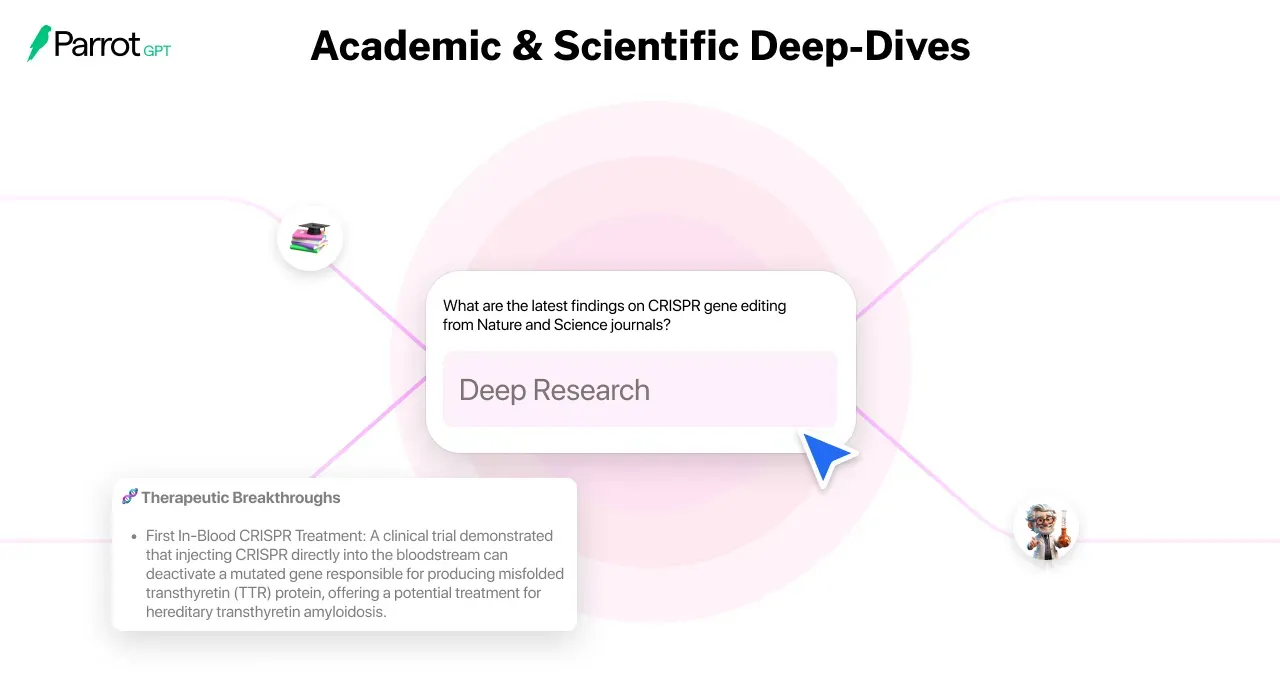
Researchers and students spend hours navigating studies. Deep Research can streamline that process.
It can summarize peer-reviewed papers, compare theories, or pull contrasting views from journals. Try:
“What are the latest findings on CRISPR gene editing from Nature and Science journals?”
Or:
“Compare theories of motivation: Maslow vs. Self-Determination Theory.”
You’ll get focused overviews, key findings, and citations to credible academic sources like PubMed, JSTOR, or Google Scholar—great for building presentations or writing literature reviews.
Smart Shopping & Due Diligence
When you're evaluating products or services, Deep Research goes beyond surface-level comparisons.
Try:
“Compare Mirror and Tonal home gyms on training variety, cost, and user reviews.”
Or:
“What certifications should an electric vehicle charger have for U.S. residential use?”
The output often includes manufacturer specs, regulatory certifications (like UL or ENERGY STAR), and credible third-party reviews—handy for consumers, procurement teams, or business owners researching equipment.
The use of ChatGPT Deep Research is not limited to these industries.
- Healthcare professionals can use it to scan clinical guidelines or compare treatment protocols.
- Marketers can gather competitive insights or analyze campaign trends.
- Tech teams can use it to pull technical specs, compare tools, or evaluate security standards.
- Even educators, journalists, and policy advisors can benefit when the goal is clear, sourced information - fast.
In short, if your work depends on trustworthy data and sharp synthesis, this tool fits right into your workflow.
Conclusion
ChatGPT Deep Research delivers what most tools can’t—fast, reliable, and well-cited insights.
We broke down how it works, why it matters, and where it fits best. From legal analysis to scientific reviews, it’s built for people who need answers they can trust. And if you know how to prompt it right, it’s like having a sharp research assistant at your fingertips.
If accuracy matters in your work, this is your edge.
Try Deep Research inside ChatGPT Plus and experience the upgrade yourself.
Frequently Asked Questions (FAQs)
Where do I find Deep Research on ChatGPT Pro?
If you're using ChatGPT Pro, you can access Deep Research from multiple places. It’s available as a quick button right below the message box on the chat screen.
You might also find it through the mode selector at the top of the chat or inside the Explore GPTs section.
Is ChatGPT Deep Research free?
Deep Research is partially available for free users. Free users get 5 Deep Research tasks per month using a lightweight version powered by the o4-mini model.
For full access with more advanced capabilities and more monthly tasks, you’ll need to subscribe to ChatGPT Plus, Pro, Team, or Enterprise plans.
How expensive is ChatGPT Deep Research?
The cost of using ChatGPT Deep Research depends on your subscription: ChatGPT Plus ($20/month), Pro ($40/month), Teams ($25/user/month), and Enterprise (custom pricing).
There's no extra charge for Deep Research once you're subscribed to any of these plans.
Can ChatGPT be used for research?
Yes, especially with Deep Research mode. It’s ideal for tasks like summarizing studies, comparing laws, analyzing markets, or validating product certifications. Always review citations to ensure the information meets your specific research standards.
Can I trust the citations provided by Deep Research?
Yes, citations come from reliable sources such as journals, news outlets, and research databases. Always cross-check the links for context, especially in legal or financial use cases.
Can I use ChatGPT Deep Research on mobile?
While it works on mobile, the best experience is on desktop due to formatting and citation layout. It’s easier to review source links and scan structured outputs on a larger screen.


